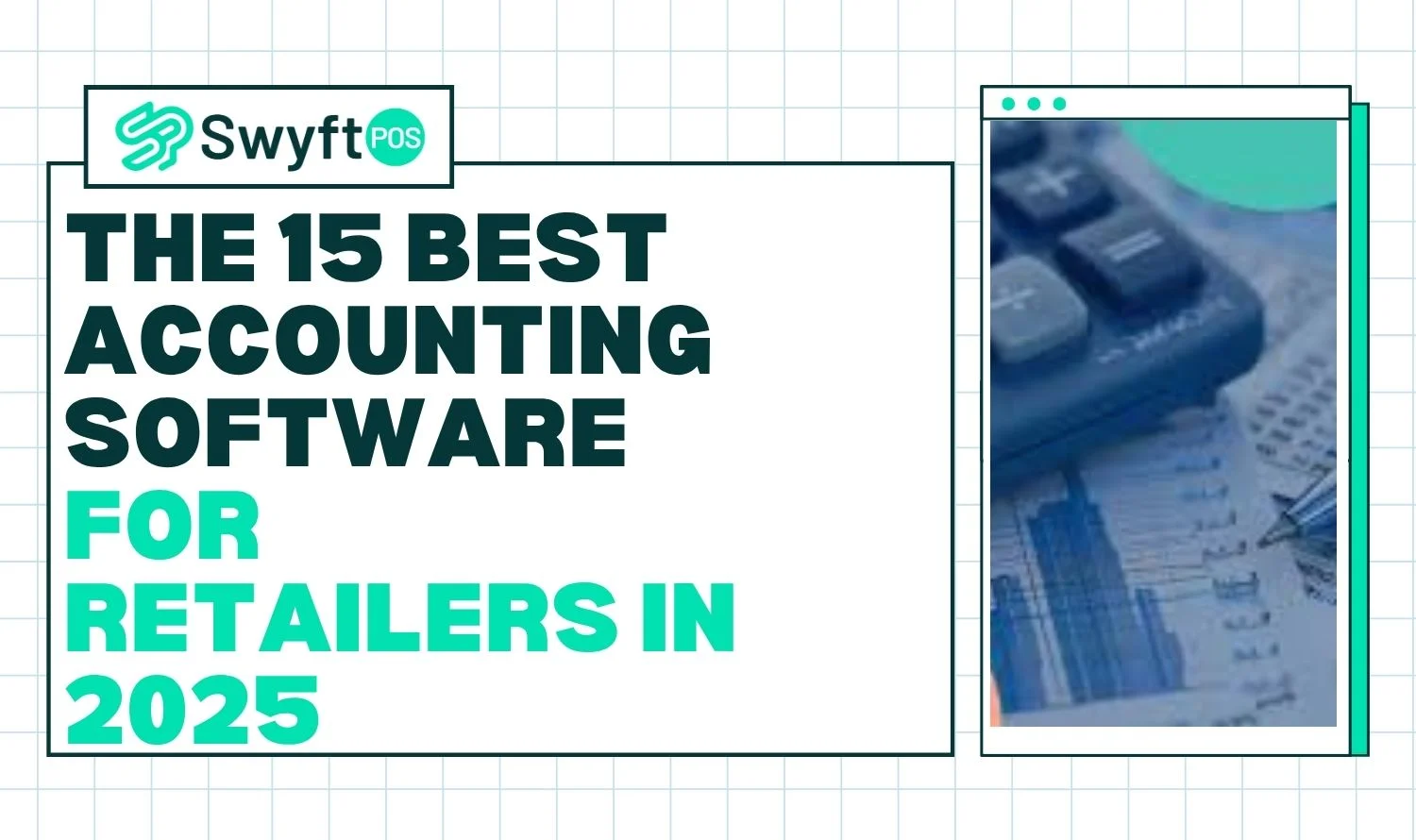Retail moves fast. Margins are tight, channels are many, and inventory changes by the hour. The right accounting stack keeps your numbers clean, your cash flow predictable, and your decisions grounded in real data. Below is a human, no-jargon tour of the best accounting software for retailers right now, plus when to choose each one.
How we picked:
- Must support retail realities like inventory, multi-channel sales, and payments.
- Strong track record in 2024–2025 product updates or recognition.
- Clear documentation on inventory, reporting, or retail workflows.
- Good ecosystem or integrations for POS and eCommerce.

For a quick pulse on what is hot in 2025 across accounting suites, recent roundups and vendor updates confirm a push toward automation, mobile, and tighter inventory controls.
Top 15 Accounting Tools Every Retailer Needs
Here are the top retail accounting software solutions for retailers and grocers alike:
1) QuickBooks Online
A powerful, all-in-one accounting solution trusted by retailers for accuracy, automation, and effortless scalability.
Best for:
Most small to mid-size retailers want familiar workflows and strong integrations.
Why it stands out:
Easy inventory tracking inside QuickBooks Online Plus and Advanced, with stock alerts and item reporting that non-accountants can read. You can track what is on hand, get restock alerts, and see insights on items you buy and sell.
Retail fit tips:
Use class and location tracking to separate online vs store sales. Pair with your POS to post daily summaries rather than every receipt. QuickBooks maintains active retail pages and guidance for inventory and purchasing at scale.
2) Xero
A clean, cloud-based platform designed to simplify bookkeeping while keeping inventory and sales perfectly aligned.
Best for:
Teams that like clean UX, unlimited users, and a solid app ecosystem.
Why it stands out:
Xero’s inventory tools keep counts and costs synced, and its 2025 updates added bulk inventory adjustments and smoother purchasing. That saves time during stock counts and seasonal reorders.
Retail fit tips:
Plug in an inventory or eCommerce add-on for barcodes and deeper warehousing if needed.
3) Zoho Books (+ Zoho Inventory add-on)
An intuitive retail accounting software suite built for automation-driven retailers looking for speed, flexibility, and value.
Best for:
Price-sensitive retailers that want automation without losing features.
Why it stands out:
Fast product velocity in 2025. Zoho added unit conversions for batch and bin-tracked items in Books, while Zoho Inventory added barcode scanning for picklists and WhatsApp shipping notifications.
Retail fit tips:
Run Books for accounting and layer Inventory for advanced stock, pick/pack, and channel sync.
4) Sage Intacct Retail (with Brightpearl)
Engineered for retail finance teams that need real-time insights and full operational control in one platform.
Best for:
Scaling retailers and brands that need real multi-entity, multi-currency accounting with retail ops in one place.
Why it stands out:
A retail-specific cloud platform that connects eCommerce platforms, automates accounting, and centralizes retail operations. Sage has been rolling out AI-assisted finance automation through 2025 as well.
Retail fit tips:
Ideal when you outgrow entry-level tools and need strong controls, multi-location, and advanced reporting.
5) Oracle NetSuite
A robust ERP backbone delivering accounting, inventory, and forecasting tools retailers can trust at scale.
Best for:
Mid-market and enterprise retailers that want ERP depth with accounting at the core.
Why it stands out:
NetSuite’s retail accounting includes GL, AR, AP, tax, fixed assets, and close management. The 2025.2 release streamlines planning and adds new analytics that help finance teams close faster.
Retail fit tips:
Great when you need one database for finance, inventory, and order management across channels.
6) Microsoft Dynamics 365 Business Central
Built to unify retail data, automate finance, and give decision-makers instant visibility across every store.
Best for:
Retailers already invested in Microsoft 365, Power BI, and Azure.
Why it stands out:
Full finance suite with strong reporting and a large app marketplace. Microsoft’s own documentation highlights built-in financial reports and flexible layouts for Balance Sheet, P&L, and Cash Flow.
Retail fit tips:
Pair with a retail extension from AppSource to manage POS and store ops alongside accounting.
7) FreshBooks
A lightweight yet professional solution crafted for retailers who prioritize simplicity, clarity, and client experience.
Best for:
Boutique retailers, pop-ups, or service-heavy shops that need simple invoicing, expenses, and reports.
Why it stands out:
Exceptionally friendly invoicing and time tracking, with clear pricing and frequent promos in 2024–2025.
Retail fit tips:
Works best if your sales run through a POS or eCommerce app and you rely on FreshBooks for back-office accounting and billing.
8) Wave
Perfect for entrepreneurs entering retail, offering easy accounting with zero cost and full transparency.
Best for:
New retailers and side hustles that need essentials on a budget.
Why it stands out:
Free core accounting and invoicing with a paid Pro plan for more automation. Wave documents its security posture and payment pricing clearly.
Retail fit tips:
Use when cash is tight. Upgrade later or connect to payment tools as you grow.
9) Sage Accounting (Sage Business Cloud Accounting)
An accessible cloud solution bridging small-business needs with advanced accounting and future scalability.
Best for:
Small retailers that want straightforward cloud accounting with multi-user support and growth paths into Sage Intacct later.
Why it stands out:
Often cited for value and multi-user readiness in small-business rankings through 2025.
Retail fit tips:
Keep SKUs tidy and lean on bank feeds for quick reconciliations.
10) Odoo Accounting
Open-source power built for customization, connecting POS, inventory, and accounting in a single digital ecosystem.
Best for:
Technical teams that want a modular, open approach across POS, inventory, and finance.
Why it stands out:
A single platform that can run POS, inventory, and accounting in one place with deep customization.
Retail fit tips:
Budget time for implementation. The payoff is a unified system rather than many separate apps.
11) Zoho Books + Shopify or BigCommerce
A seamless connection for eCommerce-driven retailers needing end-to-end sync between store sales and accounting.
Best for:
D2C brands that want affordable accounting tied to their storefronts.
Why it stands out:
Zoho’s ecosystem integrates with major eCommerce platforms and automates invoices, fees, and taxes, while Inventory handles stock and pick/pack.
Retail fit tips:
Use Zoho Flow or native connectors to reduce manual entries from your store into accounting.
12) QuickBooks Online + modern retail stack
A familiar favorite upgraded with smart retail apps that automate inventory and boost efficiency.
Best for:
Omnichannel retailers who prefer QuickBooks but need advanced inventory from third-party apps.
Why it stands out:
The QuickBooks App Store keeps adding retail and inventory extensions, including AI-assisted tools for invoice and stock automation in 2025.
Retail fit tips:
Start with core QBO inventory, then add an app for barcodes, multi-warehouse, or forecasting when growth demands it.
13) Dynamics 365 Business Central + Retail extension
Ideal for retail chains seeking unified store management and financial tracking under the same ecosystem.
Best for:
Chain retailers that want one Microsoft stack for stores and back office.
Why it stands out:
AppSource offers retail extensions that bring POS and store controls into Business Central, while finance stays native.
Retail fit tips:
Combine with Power BI to build daily profitability and sell-through dashboards.
14) NetSuite with retail edition
Enterprise-grade power uniting finance, supply chain, and retail analytics for complete visibility and control.
Best for:
Brands that need one version of the truth across wholesale, retail, and ecommerce.
Why it stands out:
NetSuite’s accounting software for grocery stores and retail edition combines financials, inventory, and order management with role-based dashboards and 2025 updates focused on planning and close efficiency.
Retail fit tips:
Invest in implementation. You get scale, controls, and room for global growth.
15) Zoho Books + Zoho Inventory (advanced)
Combines affordability with serious automation for retailers scaling beyond spreadsheets and manual stock counts.
Best for:
Retailers who want barcode-driven pick/pack, batch or serial tracking, and affordable automation.
Why it stands out:
Mid-2025 features include barcode scanning for picklists and unit conversion for batch and bin-tracked items. That is a big win for accuracy during seasonal peaks.
Retail fit tips:
Great bridge between entry-level systems and enterprise ERPs when your catalog and order volume climb.
Buying Checklist for Retailers
1) Inventory Depth
Do you need simple counts or advanced features like batch, bin, barcodes, and multiple warehouses. QuickBooks Online and Xero handle basics well. Zoho Inventory adds bins, batches, and barcode workflows. NetSuite and Intacct cover enterprise depth.

2) Omnichannel Sync
Your accounting should accept clean summaries from POS and ecommerce rather than hundreds of row-level orders. Intacct Retail and NetSuite offer native retail connectors. Zoho and QuickBooks rely on catalogs of integrations that keep growing in 2025, especially for accounting software for grocery stores.
3) Closing and Reporting
If the month-end drags, look for built-in reports and close automation. Business Central documents robust financial reports. NetSuite’s 2025.2 brings more planning and close enhancements.
4) Budget and Runway
Wave and Zoho can stretch a lean budget. FreshBooks keeps invoicing simple. As scale arrives, Sage Intacct or NetSuite pays off in control and auditability.
5) Update Cadence
Active product roadmaps matter. Xero and Zoho shipped meaningful inventory updates in 2025. QuickBooks continues to promote retail and inventory resources.
Example Stacks by Retail Stage
Pop-up or Weekend Market
Wave or FreshBooks for accounting, Square or Shopify POS for sales, then post summaries into accounting. Wave keeps core tasks free and secure with bank connections and mobile invoicing.
Growing Single-location Store
QuickBooks Online with built-in inventory. Add an app for barcodes when SKUs explode.
Multi-store or Omnichannel
Xero or Zoho Books plus a retail inventory layer for barcodes, bins, and picklists. Zoho’s 2025 inventory updates improve pick/pack speed during seasonal spikes.
Scaling Brand with Wholesale and D2C
Sage Intacct Retail or Oracle NetSuite for consolidated financials, inventory, and orders in one system. Both target retail complexity and financial control.
Final Word
There is no single best accounting app for every retailer. There is a best fit for your size, channels, and appetite for complexity. Start with inventory and order volume, pick the simplest tool that handles your reality today, and make sure it has a clear path to the next level.
If you want, share your store size, POS, and channels, and we will recommend a 2-step plan: what to deploy now and what to graduate into later.
Still managing books manually? It’s slowing you down. Let our experts at Swyft POS help sync your sales, inventory, and accounting automatically.
FAQs
1. What makes accounting software essential for retailers in 2025?
It simplifies financial tracking, automates reports, manages inventory, and syncs seamlessly with POS systems. It helps retailers make faster, data-driven decisions while saving time and reducing costly errors.
2. How does cloud-based accounting benefit retail businesses?
Cloud accounting gives retailers real-time access to financial data, supports multiple devices, and automates updates. It’s perfect for busy stores managing both in-store and online transactions simultaneously.
3. Which accounting software works best with POS systems?
Tools like QuickBooks, Xero, and Zoho integrate easily with POS systems, ensuring accurate, automated transaction recording and effortless financial syncing.
4. How do I choose the right accounting software for my store?
Evaluate your store size, sales volume, POS compatibility, and inventory needs. Look for automation, scalability, and reliable support to future-proof your business finances.
5. Can small retailers afford premium accounting tools?
Yes, many tools like Wave and Zoho Books offer free or affordable plans. They integrate easily for complete financial control without breaking the budget.





